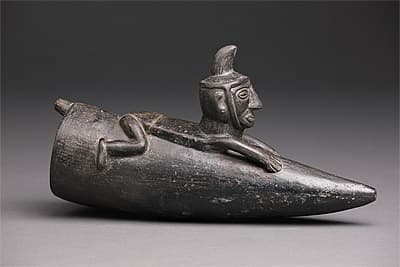
INCA culture 1400 – 1533 AD
Vessel in the form of a man on a reed raft 1400-1533 AD ceramic , blackware, smudge-fired14.8 (h) x 27.8 (w) cm Ministerio de Cultura del Perú: Museo Nacional de Arqueología, Antropología e Historia del Perú, Photograph: Daniel Giannoni
A man with a small headdress, wearing a loincloth, clings to his boat (caballito de totora). Riders straddled the vessels, made from large totora reeds, hence the Spanish term ‘totora pony’. The boats, also called rafts or balsas, were used for fishing. Fishermen trailed their nets from them, and collected their catch in the boat’s cavity. The craft plied the waters of Peru from ancient times, and similar vessels are still used for fishing on the north coast today.
Blackware ceramics are produced by smudge firing, and are sometimes polished to give an even, dark, silvery-grey sheen. Like all ancient Andean pottery, they ‘were fired in an oxidizing atmosphere, where oxygen was allowed to circulate freely around the objects’; but to make smudge blackware:
when the ceramics reached peak temperature, more fuel was added and the entire batch of pots was quickly buried with sand or fine soil. The newly added fuel around the pots produced an intense smoke that was trapped by the soil burying the kiln. This smoke, in direct contact with the hot pottery, drove carbon deep into or even clear through the vessel walls, sometimes giving the objects a metallic appearance.1
Potters built up their forms in coils, as the wheel was not known in pre-Columbian America. Many common objects were made in moulds, although this work is so unusual that it is more likely free-form. It would have been used in rites, to ask the gods for a good catch or to wish good fortune on the fisherman, and would probably have been buried to accompany the dead, and to ensure them a supply of fish on their eternal journey.
Christine Dixon
1. Christopher B. Donnan, Ceramics of ancient Peru, Los Angeles: Fowler Museum of Cultural History, UCLA 1992, p. 20.
A man with a small headdress, wearing a loincloth, clings to his boat (caballito de totora). Riders straddled the vessels, made from large totora reeds, hence the Spanish term ‘totora pony’. The boats, also called rafts or balsas, were used for fishing. Fishermen trailed their nets from them, and collected their catch in the boat’s cavity. The craft plied the waters of Peru from ancient times, and similar vessels are still used for fishing on the north coast today.
Blackware ceramics are produced by smudge firing, and are sometimes polished to give an even, dark, silvery-grey sheen. Like all ancient Andean pottery, they ‘were fired in an oxidizing atmosphere, where oxygen was allowed to circulate freely around the objects’; but to make smudge blackware:
when the ceramics reached peak temperature, more fuel was added and the entire batch of pots was quickly buried with sand or fine soil. The newly added fuel around the pots produced an intense smoke that was trapped by the soil burying the kiln. This smoke, in direct contact with the hot pottery, drove carbon deep into or even clear through the vessel walls, sometimes giving the objects a metallic appearance.1
Potters built up their forms in coils, as the wheel was not known in pre-Columbian America. Many common objects were made in moulds, although this work is so unusual that it is more likely free-form. It would have been used in rites, to ask the gods for a good catch or to wish good fortune on the fisherman, and would probably have been buried to accompany the dead, and to ensure them a supply of fish on their eternal journey.
Christine Dixon
1. Christopher B. Donnan, Ceramics of ancient Peru, Los Angeles: Fowler Museum of Cultural History, UCLA 1992, p. 20.
A man with a small headdress, wearing a loincloth, clings to his boat (caballito de totora). Riders straddled the vessels, made from large totora reeds, hence the Spanish term ‘totora pony’. The boats, also called rafts or balsas, were used for fishing. Fishermen trailed their nets from them, and collected their catch in the boat’s cavity. The craft plied the waters of Peru from ancient times, and similar vessels are still used for fishing on the north coast today.
Blackware ceramics are produced by smudge firing, and are sometimes polished to give an even, dark, silvery-grey sheen. Like all ancient Andean pottery, they ‘were fired in an oxidizing atmosphere, where oxygen was allowed to circulate freely around the objects’; but to make smudge blackware:
when the ceramics reached peak temperature, more fuel was added and the entire batch of pots was quickly buried with sand or fine soil. The newly added fuel around the pots produced an intense smoke that was trapped by the soil burying the kiln. This smoke, in direct contact with the hot pottery, drove carbon deep into or even clear through the vessel walls, sometimes giving the objects a metallic appearance.1
Potters built up their forms in coils, as the wheel was not known in pre-Columbian America. Many common objects were made in moulds, although this work is so unusual that it is more likely free-form. It would have been used in rites, to ask the gods for a good catch or to wish good fortune on the fisherman, and would probably have been buried to accompany the dead, and to ensure them a supply of fish on their eternal journey.
Christine Dixon
1. Christopher B. Donnan, Ceramics of ancient Peru, Los Angeles: Fowler Museum of Cultural History, UCLA 1992, p. 20.

